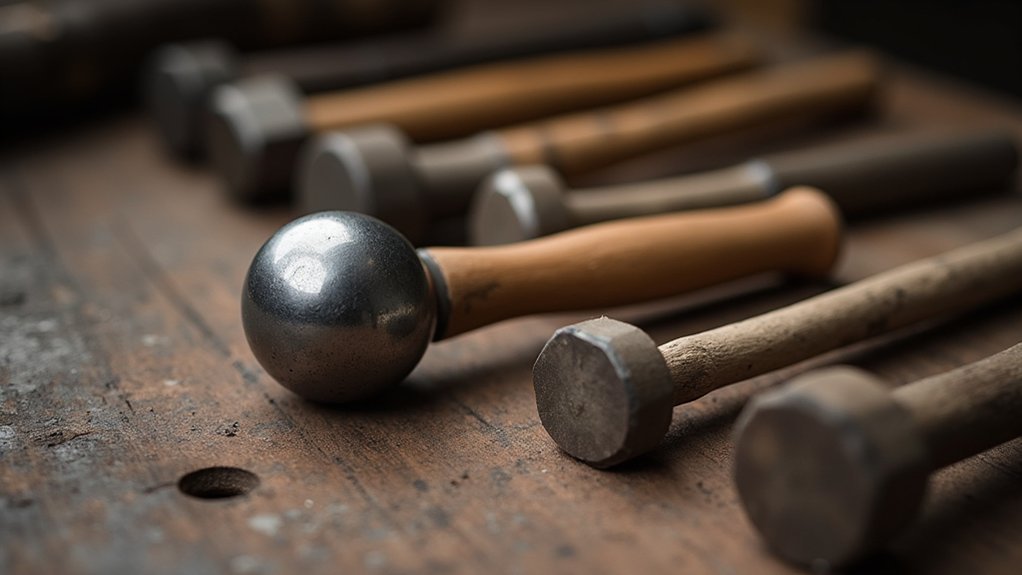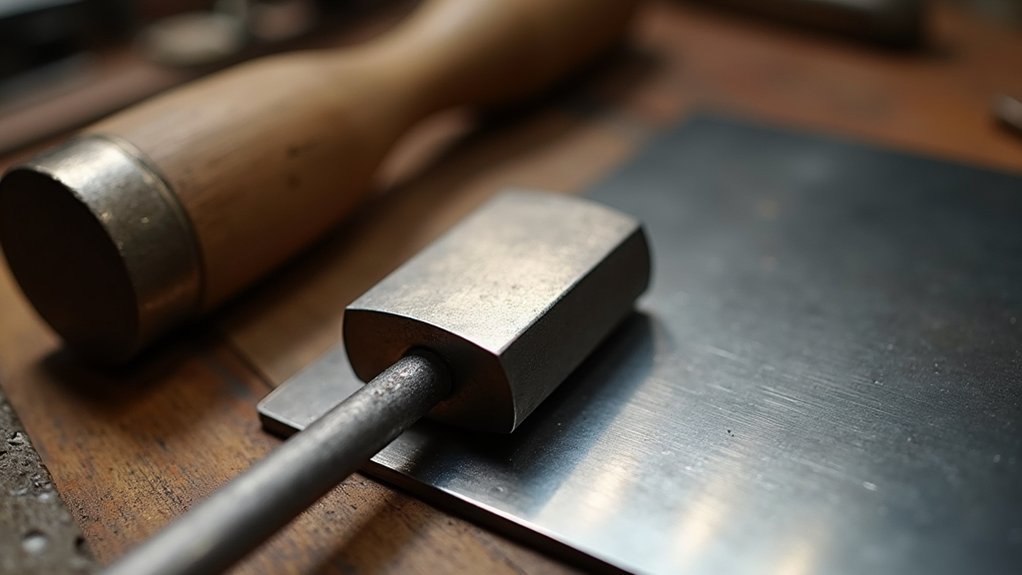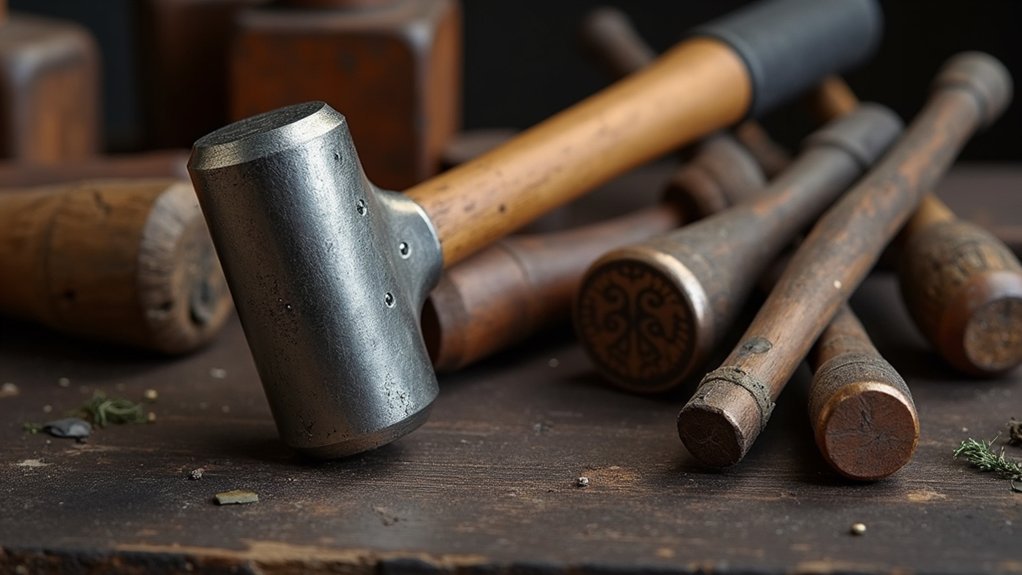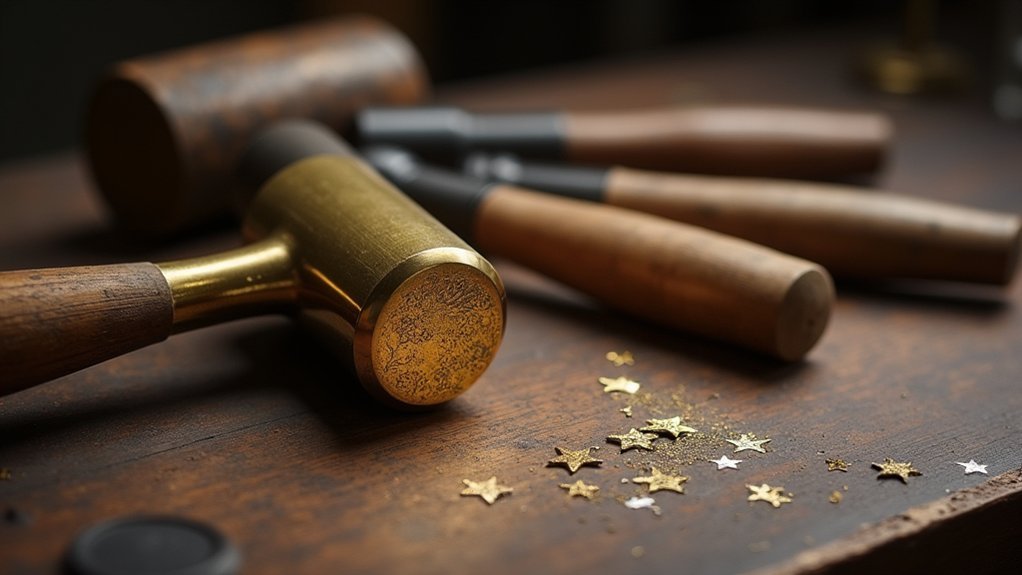You’ll need essential hammers like the ball pein for general metalwork, chasing hammers for detailed relief work, and planishing hammers for mirror-like finishes. Rawhide mallets prevent surface damage on precious metals, while texturing hammers create unique patterns. Raising hammers with cross pein designs excel at convex shaping, and specialized mallets in nylon, urethane, or brass offer different striking characteristics. Each tool serves specific functions that’ll elevate your craftsmanship when you understand their proper applications.
Ball Pein Hammer: The Versatile Essential for Every Metalworker

Precision meets versatility in the ball pein hammer, a dual-faced tool that’s become indispensable for metalworkers across all skill levels.
You’ll find its flat face perfect for general hammering tasks, while the rounded pein creates clean indentations and shapes metal without unwanted marks. This ball pein hammer excels in jewelry making, where you need controlled force for forming sheet metal and setting rivets.
Weighing between 8-16 oz, you’ll get ideal balance between control and striking power for precise metal manipulation.
The hardened steel construction guarantees your ball pein hammer withstands years of heavy use.
Whether you’re texturing surfaces, striking metal stamps, or shaping delicate components, this tool delivers consistent results that make it essential in every metalworker’s arsenal.
Rawhide Mallet: Gentle Forming Without Surface Damage
When you’re working with precious metals that can’t afford surface damage, you’ll reach for a rawhide mallet every time.
The soft rawhide material won’t leave scratches or dents on your workpiece, making it perfect for ring resizing and delicate forming operations.
You’ll have complete control over the impact force, allowing you to shape metal gradually without the harsh blows that harder hammers deliver.
Prevents Metal Scratching
Since delicate metalwork requires tools that won’t compromise surface quality, rawhide mallets have become essential instruments for jewelers who need to form and reshape metal without leaving scratches or dents.
You’ll find that a rawhide mallet’s soft composition absorbs shock during impact, protecting your precious metals from the surface damage that harder hammers typically cause.
When you’re working with gold, silver, or copper, this mallet prevents unwanted marks while allowing precise shaping.
The rawhide material creates a cushioned blow that won’t alter your metal’s finish, making it perfect for ring resizing and other delicate tasks.
You can maintain your pieces’ original surface integrity while achieving the exact forming results you need for professional-quality jewelry work.
Ring Resizing Applications
Ring resizing represents one of the most demanding applications where a rawhide mallet’s gentle forming capabilities truly shine.
When you’re adjusting ring sizes, you need precise control without risking surface damage to valuable metals. The rawhide mallet’s soft material absorbs shock effectively, preventing unsightly marks or scratches that harder hammers would leave behind.
You’ll find this tool particularly valuable when working with softer metals like gold and silver, which traditional metal hammers can easily mar.
The rawhide mallet allows you to gradually reshape rings with even pressure distribution, eliminating risks of excessive stretching or unwanted deformation. This controlled approach guarantees you maintain the ring’s structural integrity while achieving accurate size adjustments, making it an indispensable tool for professional-quality jewelry work.
Soft Impact Control
Although traditional metal hammers deliver forceful blows that can dent and scratch precious metals, rawhide mallets offer you unmatched soft impact control that transforms your metalworking approach.
You’ll find that a rawhide mallet’s gentle material absorbs shock effectively, preventing unsightly marks and scratches on delicate surfaces during forming processes.
When you’re shaping jewelry pieces, this tool gives you precise control while maintaining your metal’s integrity. The soft impact allows you to create smooth curves and surfaces without the harsh effects you’d experience with harder hammers.
You can select from various sizes and weights to match your specific needs, whether you’re doing light tapping work or more substantial forming applications that require consistent, controlled pressure.
Chasing Hammer: Precision Tool for Detailed Relief Work
Precision defines the chasing hammer’s role in metalworking, where its unique dual-face design sets it apart from standard hammers.
You’ll find the domed face perfect for creating intricate designs while the flat side excels at detailed relief work without excessive metal stretching.
Your chasing hammer’s balanced construction delivers superior control when striking metal stamps, allowing you to create artistic imprints and textures on jewelry pieces with confidence.
Whether you’re a beginner or advanced jeweler, this versatile tool enhances your metalworking capabilities considerably.
The thoughtful weight distribution reduces forearm fatigue during extended use, making it your go-to choice for detailed projects.
You’ll appreciate how the chasing hammer’s ergonomic design maintains precision throughout long crafting sessions, ensuring consistent results in your most intricate metalwork endeavors.
Planishing Hammer: Achieving Professional Smooth Finishes

When you’re seeking that mirror-like finish on your metalwork, the planishing hammer becomes your most trusted ally for transforming rough, formed pieces into polished perfection. This specialized tool features a smooth face that eliminates surface imperfections without excessively stretching your material, giving you complete control over the finishing process.
You’ll achieve best results when using your planishing hammer with a metal stake or anvil for proper support. The weight selection matters greatly – heavier hammers deliver more flattening force for thick materials, while lighter versions offer delicate precision work.
Jewelers particularly value this hammer’s ability to create high-quality finishes that enhance aesthetic appeal. The planishing hammer’s smooth surface guarantees you’ll achieve professional results every time.
Texturing Hammer: Creating Unique Surface Patterns and Effects
You’ll discover that texturing hammers release countless surface pattern techniques, from creating delicate dimples to bold linear impressions across your metal surfaces.
The key to mastering texture effects control lies in varying your strike force, angle, and rhythm to achieve consistent or deliberately varied patterns.
With practice, you can transform plain metal into visually compelling surfaces that catch light and add professional depth to your jewelry pieces.
Surface Pattern Techniques
Artistry comes alive when you master the texturing hammer, a specialized tool that transforms plain metal surfaces into enchanting works of art.
You’ll discover countless surface pattern techniques by adjusting your impact force and strike angle. Light taps create subtle impressions, while firmer strikes produce bold, pronounced textures.
The texturing hammer’s interchangeable faces offer endless creative possibilities. You can create crosshatch patterns, dimpled surfaces, or flowing organic textures across gold, silver, and copper.
Experiment with overlapping strikes to build complex layered effects, or use consistent spacing for geometric patterns.
Your technique determines the final result. Vary your hammer angle from perpendicular strikes for deep impressions to glancing blows for elongated marks.
This versatility lets you develop signature textures that distinguish your handmade pieces from mass-produced jewelry.
Texture Effects Control
Mastering texture effects control requires understanding how pressure, angle, and rhythm work together to produce consistent results across your metal surface.
When wielding your texturing hammer, you’ll discover that light, consistent strikes create subtle patterns, while heavier blows produce deeper impressions. Varying your hammer’s angle changes how the patterned face contacts the metal, creating different visual effects from the same tool.
Maintain steady rhythm to guarantee uniform spacing between strikes. Overlapping strikes can create complex layered textures, but requires careful control to avoid muddying your pattern.
Practice on scrap metal first to understand how your specific texturing hammer responds to different pressures and angles. The key is developing muscle memory for consistent force application, allowing you to replicate successful texture effects across multiple jewelry pieces with confidence and precision.
Riveting Hammer: Specialized Tool for Joining and Bark Textures

Two distinct faces make the riveting hammer an indispensable tool for metalworkers who need precision in both joining pieces and creating decorative textures.
You’ll find the flat round face perfect for compressing metal during riveting, ensuring secure joints without damaging surrounding material. The specialized design delivers controlled strikes that maintain your work’s integrity.
The flat round face compresses metal precisely during riveting, creating secure joints while protecting surrounding material from damage.
Your riveting hammer’s weight and balance reduce fatigue during extended metalworking sessions while providing the precision you need.
Made from durable alloyed steel, it resists wear and delivers long-lasting performance across various applications.
You can enhance your metalwork’s aesthetic quality by using this hammer to add bark-like textures and dimension, making it valuable for both functional and decorative pieces.
Raising Hammer: Cross Pein Design for Convex Shaping
You’ll find the raising hammer’s cross pein design gives you superior control when shaping convex curves in metal without overstretching the material.
The pein’s angled surface lets you push and form the metal gradually, creating smooth changes perfect for bangles, cuffs, and other curved jewelry pieces.
This specialized tool’s heavier head provides the necessary force to work thicker metals while maintaining the precise control you need for professional-quality convex shaping.
Cross Pein Benefits
When you’re shaping convex forms in metalwork, a raising hammer’s cross pein design delivers concentrated striking force that’s essential for precise metal manipulation.
This specialized head configuration prevents excessive metal stretching while creating three-dimensional shapes like bowls and cuffs.
The cross pein offers four key advantages:
- Controlled Force Distribution – Concentrates impact precisely where needed without damaging surrounding metal
- Versatile Surface Working – Functions effectively on both flat and curved surfaces during forming
- Enhanced Balance – Weight distribution reduces hand fatigue during extended metalworking sessions
- Tool Compatibility – Works seamlessly with dollies and other forming tools for complex shapes
You’ll find this design maximizes your creative possibilities while maintaining the control necessary for detailed jewelry work and professional-quality finishes.
Convex Shaping Techniques
Three fundamental techniques form the core of successful convex shaping with your raising hammer’s cross pein design. You’ll master planishing, where you use gentle, overlapping strikes to smooth and compress the metal surface. The raising technique involves systematic circular movements from the center outward, gradually creating your desired curvature. Finally, forming requires controlled pressure to shape complex curves without excessive stretching.
| Technique | Hammer Position | Result |
|---|---|---|
| Planishing | Flat contact | Smooth surface |
| Raising | Angled strikes | Gradual curves |
| Forming | Controlled pressure | Complex shapes |
Your raising hammer’s weight provides the compression needed for effective shaping while the domed face guarantees even pressure distribution. Practice proper technique to avoid unwanted marks and maintain metal integrity throughout the convex shaping process.
Stamping Hammer: Brass-Faced Power for Metal Impressions

Precision defines every successful metal stamping project, and the stamping hammer delivers exactly that with its specialized brass-faced design.
You’ll find these versatile tools feature dual faces—one flat for metal flattening and one domed for shaping work.
Weight selection directly impacts your results. Choose heavier stamping hammer models for deeper impressions and lighter versions for detailed work.
Premium brands like Fretz combine brass and steel faces, giving you enhanced striking power with superior durability.
Master these essential techniques for best results:
- Strike with controlled force to prevent metal damage
- Maintain consistent angle for uniform impressions
- Use proper grip for maximum control and comfort
- Practice rhythm to achieve professional-quality stamping
Your technique determines success—controlled strikes produce clear, precise impressions while protecting your metal surfaces.
Embossing Hammer: Dual Ball Peins for Dramatic Texturing
Beyond flat impressions, the embossing hammer transforms metal surfaces into sculptural artworks with its distinctive dual ball pein design.
You’ll discover this specialized tool creates dramatic textures that elevate your jewelry from ordinary to extraordinary. The embossing hammer’s unique shape produces varied patterns and intricate designs while maintaining your metal’s structural integrity.
You can achieve stunning three-dimensional effects on flat surfaces, adding depth and visual interest to your pieces.
This versatile tool works beautifully across different metals—silver, gold, and brass all respond excellently to embossing techniques.
Whether you’re crafting artistic jewelry or adding decorative elements to metalwork projects, the embossing hammer’s dual ball peins give you precise control over texture creation, making it invaluable for advanced metalworking applications.
Specialized Mallets: Nylon, Urethane, and Brass Options

Material composition makes all the difference when selecting mallets for delicate jewelry work.
The foundation of successful jewelry making lies in understanding how mallet materials directly impact your craftsmanship results.
You’ll find that nylon mallets excel at shaping metals without leaving unwanted marks, making them essential for precision forming. Urethane options like the Bonny Doon model deliver superior force transmission while maintaining exceptional durability for demanding projects.
Brass mallets provide the weight and solid impact you need for riveting and stamping applications.
Consider these key advantages when choosing your specialized mallet:
- Nylon mallets protect delicate surfaces from scratches and dents
- Urethane models offer ideal force transfer for heavy-duty forming
- Brass options deliver precise strikes for stamping and riveting
- Proper selection enhances work quality while extending tool longevity
Using the right mallet greatly improves your metalworking efficiency while protecting both your projects and tools.
Frequently Asked Questions
What Hammer Is Best for Metal Work?
You’ll want a ball pein hammer for general metalwork since it’s versatile for shaping and texturing. However, you’ll need specialized hammers like planishing or texturing hammers for specific finishing tasks.
What Hammer to Use for Jewelry?
You’ll want a ball pein hammer for general jewelry work since it’s most versatile. For delicate tasks like ring resizing, use a rawhide mallet to prevent scratches and damage.
What Is the Best Hammer for Metal Stamping?
You’ll want a chasing hammer for metal stamping since it’s dual-functional for flattening and shaping. For detailed work, choose a lightweight option like the ImpressArt Ergo-Angle hammer for precise strikes.
Which Hammer Is the Most Suitable Tool for General Metalwork?
You’ll find the Ball Pein Hammer’s your best choice for general metalwork. Its dual flat and rounded surfaces make it incredibly versatile for texturing and shaping metal in most applications.
In Summary
You’ve now got the essential knowledge to choose the right hammer or mallet for your metalworking projects. Whether you’re starting with a basic ball pein hammer or expanding to specialized tools like chasing and planishing hammers, each serves a unique purpose in creating quality jewelry. Don’t rush into buying everything at once—start with fundamentals and gradually build your collection as your skills and projects become more complex.





Leave a Reply